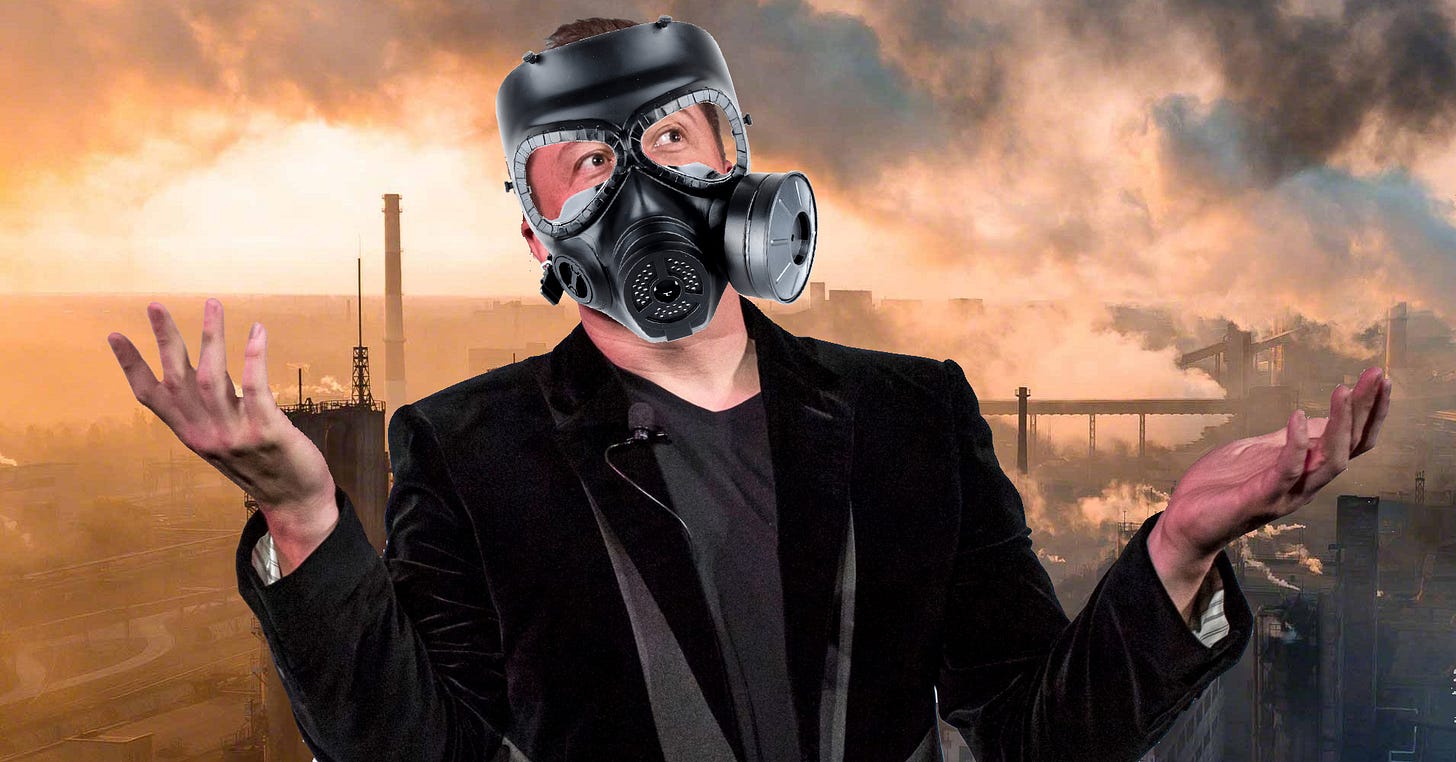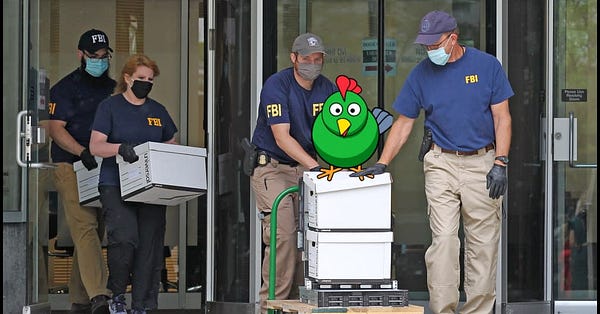Have you subscribed yet? Why not? Come on, just do it already!
Ridiculous ESG Rating of the Week
In 2010, the US EPA Criminal Enforcement division filed charges against Kinder Morgan Bulk Terminals for circumventing emissions controls on a baghouse (dust collector) used for loading fertilizer off of cargo ships:
In August 2006 and August 2007, KMPMT's local managers and supervisors falsely stated in FDEP permit applications that KMPMT would operate and maintain its air pollution emissions and control equipment in accordance with regulations, when they knew that the baghouses were not being operated and maintained properly. Moreover, from October 2006 through March 2008, KMPMT's local managers and supervisors failed to notify and report to the FDEP that its baghouse air pollution control systems were not in compliance and would continue to be out of compliance.
Facility management knowingly bypassed the emission control equipment and, tellingly, ran the operation at night in order to minimize the public visibility of the dust cloud. When KMI corporate discovered the non-compliance, they self disclosed to the State of Florida and the EPA. Criminal charges were filed.
As a result of this and a few other incidents, the EPA Suspension and Debarment division forced a consent decree on the company in 2011, whereas the company would have to undergo third party audits, maintain an independent Ethics hotline and investigation organization and re-tool all internal tracking and audit systems. This was disclosed regularly in Kinder Morgan 10-q and 10-k forms, starting with the initial notice:
In April 2011, we received Notices of Proposed Debarment from the U.S. EPA SDD. The Notices propose the debarment of KMP (along with four KMP subsidiaries), KMI, Kinder Morgan G.P., Inc., and KMR, from participation in future federal contracting and assistance activities. The Notices allege that certain of the respondents’ past environmental violations indicate a lack of present responsibility warranting debarment.
The threat of debarment was existential for the company, as their DOT regulated interstate pipelines would have been effectively shut down in the event of non-compliance.
In August of this year, Summit Midstream Partners was charged by EPA with criminal misconduct under the Clean Water Act for releasing 29 million gallons of produced water in North Dakota and then selectively withholding information from state and federal regulators:
Summit has further admitted that it knowingly did not share all relevant information regarding the volume and duration of the spill and that its reports to federal and state authorities “were incomplete and misleading,” in papers filed in court. Summit eventually reported 70,000 barrels over a 10-day period despite an internal analysis showing the discharge was more than 700,000 barrels over 143 days. Under the terms of the proposed plea agreement, Summit will serve three years of probation in which comprehensive remedial measures are required.
In addition to the $35 million dollar fine, a parallel civil agreement likewise requires process changes, third party audits and an overhaul of their internal review and auditing programs:
The civil settlement further requires Summit and Meadowlark to take concrete steps to prevent future discharges, including stringent pipeline installation, operation, and testing requirements; a centralized computational pipeline monitoring system; spill response planning and countermeasures; an environmental management system; and data management and training measures. Independent third-party audits are required to ensure that certain injunctive measures are properly developed and implemented. These compliance measures were made a condition of Summit’s probation in the proposed criminal plea agreement. The companies have also agreed to enter into a related administrative settlement with the North Dakota Industrial Commission.
Earlier this year, a plant manager at a municipal water treatment plant in Pittsburgh was indicted with criminal charges for knowingly dumping clarifier sludge into the Alleghany river:
At various points between 2010 and 2017, Paprocki and another supervisor at the plant directed PWSA employees to discharge clarifier sludge into the Allegheny in violation of PWSA’s National Pollution Discharge Elimination (NPDES) permit. Clarifier sludge is generated when raw water is converted into potable drinking water.
Not only is there liability for the Pittsburgh Water and Sewer Authority, but the manager in question faces 5 years in prison for his actions.
An astute reader may be asking “Where are you going with this?” Well, take a look at EPA’s criminal prosecution press release page. If there’s one clear trend it’s that the EPA really doesn’t like:
Dumping (this includes hazardous waste in landfills, sewage into surface waters, and pollutants into the atmosphere)
Lying to regulators about dumping waste
Intentionally dumping waste to meet production or financial goals
This quote from the Summit Midstream’s case is telling:
“Summit prioritized profits over the environment. The company’s disregard for pipeline safety resulted in pollution of the environment on a massive scale over 143 days,” said Assistant Attorney General Todd Kim of the Justice Department’s Environment and Natural Resources Division. “Summit’s conduct was criminal and its failure to immediately report the discharge a felony. This resolution holds the company financially accountable, requires enhanced compliance measures to prevent future spills, and provides compensation for North Dakota’s damaged natural resources.”
In 2016-2017, as Tesla was pushing to meet production goals on the Model 3 Sedan, all caution was thrown to the wind. Media has focused on the safety problems (injuries, fires, preventing CalOSHA from entering the facility), but some great reporting from Ed Niedermeyer and Lora Kolodny highlighted the extremely concerning environmental issues as well:
To speed up production, two former paint shop employees said temperatures in the oven used to dry paint were raised. This has led to incidents of vehicle bodies and bumpers being ruined by excessive heat and thrown out, the sources said.
This is a violation of the Clean Air Act. The overriding of process controls is an intentional act and all temperatures for ovens are regulated based on emissions calculations during permitting.
Though Tesla responded to both Kolodny’s and my reports by touting the steps it had taken to upgrade equipment, a BAAQMD document shows that another E-Scrub system was de-energized on the 21st “as investigative findings indicate that the electrically charged plates are a source of ignition for fires in spray booths.
The company knowingly turned off the electrostatic precipitator that collects highly toxic particles that cannot be combusted efficiently in the thermal oxidizer.
Two Tesla employees say that vehicle production goals have been the highest priority in recent months, sometimes at the expense of fire and environmental considerations. They said, for example, that months before the April fire, the sprinkler heads were clogged and coated at least an inch thick of paint and clear-coat. Filters below the paint booths and exhaust systems that clean and carry air into and out of the building were also visibly coated, they added.
Kolodny’s reporting on this one was outstanding, and sadly did not get the attention it deserved. Maintenance and upkeep was so terrible that filters used to protect human life in and outside of the factory that it may as well have not existed.
2-ethylhexanol and 2-butoxyethanol are each at ~5% by weight of coatings used at the factory.
2-ethylhexanol: A TWA of 1 ppm (5.33 mg/m3) is recommended to protect for central nervous system (CNS) depression including headaches, fatigue, dizziness and nausea; as well as nasal and throat irritation in exposed workers.
2-butoxyethanol: In older studies, haematotoxic effects (e.g. increased osmotic fragility, decreased haemoglobin, decreased red blood cell numbers) have been observed in mice (100–400 ppm; 483–1932 mg/m3 ), dogs (415 ppm; 2004 mg/m3 ), and monkeys (100 ppm; 483 mg/m3 ) exposed repeatedly by inhalation to 2-butoxyethanol for up to approximately 90 days (Werner et al., 1943c; Carpenter et al., 1956).
Both are known neurological toxins and carcinogens with significant short term (acute) and long term (chronic) impacts on human health and the environment.
By the way, there’s an elementary school less than mile away from the factory:
There’s absolutely no way that Tesla didn’t commit a criminal act by any reasonable interpretation of case law and corresponding reporting at the time. EPA Criminal Cases can take years to unfold, so I don’t know what the outcome will be, but in a reasonable society something sure should happen.
Meanwhile, given the precedence with Summit Midstream and Kinder Morgan (as well as countless other EPA Suspension and Debarment cases), there is the following to consider:
Tesla effectively does not have an IR or PR department
Tesla does not have an independent internal audit program
Tesla does not have an Ethics Hotline handled by a provider such as Navex. As best as I can tell, Tesla might be the only company in the S&P 500 without such a service (please correct me if I am wrong)
So, Tesla has bad scores for ESG from S&P and other providers, but that appears to mostly being a function of Elon Musk not giving a single shit about this service. And why would they?
After all, they’re a major holding of many big ESG ETFs


Cathie Wood’s ARK is launching a transparency ETF. It’s biggest projected holding? You guessed right: Tesla.
I’ve only scratched the surface here, but the ESG red flags with Tesla are almost too many to count, from Union Busting to Racist Abuse Enabling, Bitcoin Pumping, Self Dealing, SEC Fraud charges.
Embarrassing. Making 3000 pound EVs doesn’t absolve you from doing everything else in the most corrupt and horrific way possible. Oh well what are you gonna do?
Lawmaking Updates
Bloomberg Reported last week that the SEC is finally cracking down on ESG. We’re a long way from it being treated as seriously as Accounting Fraud, but at least this is a step in the right direction.
U.S. regulators have long said they’re dubious about the green and socially conscious labels that Wall Street applies to $35 trillion in so-called sustainable assets. Now, the watchdogs are hunting for proof that they’re right.
For several months, Securities and Exchange Commission examiners have been demanding that money managers explain the standards they use for classifying funds as environmental, social and governance-focused, said people familiar with the matter. The review is the SEC’s second into possible ESG mislabeling since last year -- showing the issue is a priority for the agency and a reason for the industry to worry about a rash of enforcement actions.
Another US subsidy for EVs was proposed by House dems this week, this one being worth up to $12,500 (but only $7,500 for Teslas made in a non union factory). Extremely doubtful this one will pass the Senate, but please read my post on EVs first (THEY’RE NOT THAT GREAT FOLKS!)
Tweets/Blogs/Articles that Caught our Eye

Must read thread, this kind of action alone should disqualify a company from being labeled “ESG” by any definition of the term.
Ace letter from Levine, who covers ESG loans and well as Coinbase’s ridiculous response to a Wells Notice
Doomberg is lighting up the finance substack world (Finstack? SubNance?)… Great coverage of Coinbase here as well.
ESG Hound TL;DR
Gevo Up Huge! On a LOI signed with Chevron. I have nothing to add at this point, but there’s much more to come. The company is still a turd (not a technical term)
Still working on a piece on Oatly (Ticker: OTLY), the vegan milk company with a high valuation and some ESG accusations over their heads. I am waiting for a records request to come back in before I finalize
Expect a piece on Uranium this week, hopefully.
ESG Hound Portfolio
🚀 VWTR - Vidler Water Resources, Inc - Added 7/15/21 - LONG
Price at initiation: $13.10
Current Price: $12.61( 📉-3.8% for the “fund”)
💨 GEVO - Gevo, Inc - Added 8/4/21 - SHORT
Price at initiation: $5.60
Current Price: $6.93 (📉 -23% for the “fund”) ed. note: OUCH!










